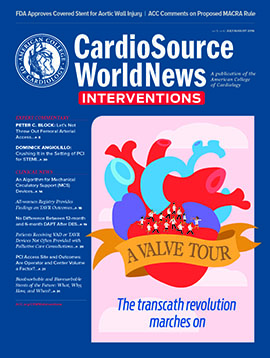Interview: Crushing It in the Setting of PCI for STEMI | Crushed Prasugrel Speeds Antiplatelet Effects
CardioSource WorldNews Interventions | We know that time is muscle. The effects of platelet inhibitory induced by oral P2Y12 receptor antagonists can be delayed in patients with STEMI undergoing PCI, which may be related to reduced absorption. CardioSource WorldNews: Interventions spoke with Dominick Angiolillo, MD, PhD, FACC, Professor of Medicine and Director of Cardiovascular Research at the University of Florida College of Medicine in Jacksonville, FL, about the Crush Study, which examined if crushing prasugrel could lead to more favorable results.
CSWN Interventions: What triggered the Crush Study?
There were several ideas that led to the design of the study. We’ve learned, over the course of the past several years, conducting a series of pharmacodynamic studies, that, although the newer P2Y12 inhibitors act more promptly, in the vast majority of patients, it doesn’t seem to be the case in patients with ST-segment elevation myocardial infarction (STEMI). There is a time delay in the onset of the effects. We also know that time is muscle, and therefore efforts to accelerate the effects of the drugs are clearly needed. Along this pathway of investigations, there was one seminal study by our colleagues in Italy and Greece called the MOJITO study (Mashed Or Just Integral pill of TicagrelOr), which actually crushed the tablets, in that specific case, ticagrelor. The study did show that there was an enhanced platelet inhibitory effect at 2 hours after giving the drug compared with the whole tablets.
We wanted to expand these findings. The Crush Study expands in three ways. First, we looked at a different drug—in this case prasugrel. Secondly, we conducted a more comprehensive pharmacodynamic study by adding more time points and more pharmacodynamics assays, just to provide confirmatory results. Finally, we wanted to have some mechanistic insights; to do so, we looked at pharmacokinetic assessments to really understand if this was attributed to a differences in drug absorption and metabolism.
So what did you find?
We randomized and analyzed 52 patients, so a relatively small study, but a very detailed physiologically based pharmacokinetic (PBPK) study. These patients were randomized in a one-to-one fashion to either crushing the pills or taking the standard whole tablets of 60 milligrams of prasugrel; in other words, six ten-milligram pills. We did a series of assessments at 7 time points using two different pharmacodynamic assays and pharmacokinetic assessments. It was a lot of work, a lot of sleepless nights to conduct these assessments. We found that there were differences in the pharmacodynamic effects already at 30 minutes versus, say, at 1 hour, 2 hours, and 4 hours. It was only after 6 hours that the two curves, or the two treatment arms actually emerged.
For the MOJITO study, the accelerated effects were a little slower, right?
They did not find it quite at 30 minutes. It was not as quick—1 hour. But it did show a difference. But out of fairness, it is important to say that they were different studies, with different drugs, with also some different type of assessments and timing of administration, etc. So we were very encouraged because we found a quick and cheap way to accelerate platelet inhibition because essentially you’re taking the same exact drug at the exact dose and just giving it a different formulation.
In the editorial comment to your paper, the writers say, “At the rate of stent thrombosis, in the first 24 hours, it’s still pretty significant for many places.” And so anything you can do to speed up the process and protect these patients has to be a good thing.
Absolutely. And crushing is a way; it’s really simple. You know, there are also some other comments from others that I’ve heard: “It’s complicated to crush the tablets.” We used a syringe crusher, and the approximate time to prepare the crushed sample was around 2, max 3 minutes. So it’s very, very simple. With the syringe crusher, you put in the six tablets. You crush them. It turns into a powder in a matter of a couple of twists. Take some water. Shake it. Put it in a cup. Take some residue. Take some more water to rinse it. Put it in a cup. Drink. And it’s done.
Reference:
- Rollini F, Franchi F, Hu J, et al. J Am Coll Cardiol. 2016;67(17):1994-2004.

|
Read the full July/August issue of CardioSource WorldNews Interventions at ACC.org/CSWNI |
Keywords: CardioSource WorldNews Interventions, Blood Platelets, Medicine, Purinergic P2Y Receptor Antagonists, Ticlopidine
< Back to Listings
